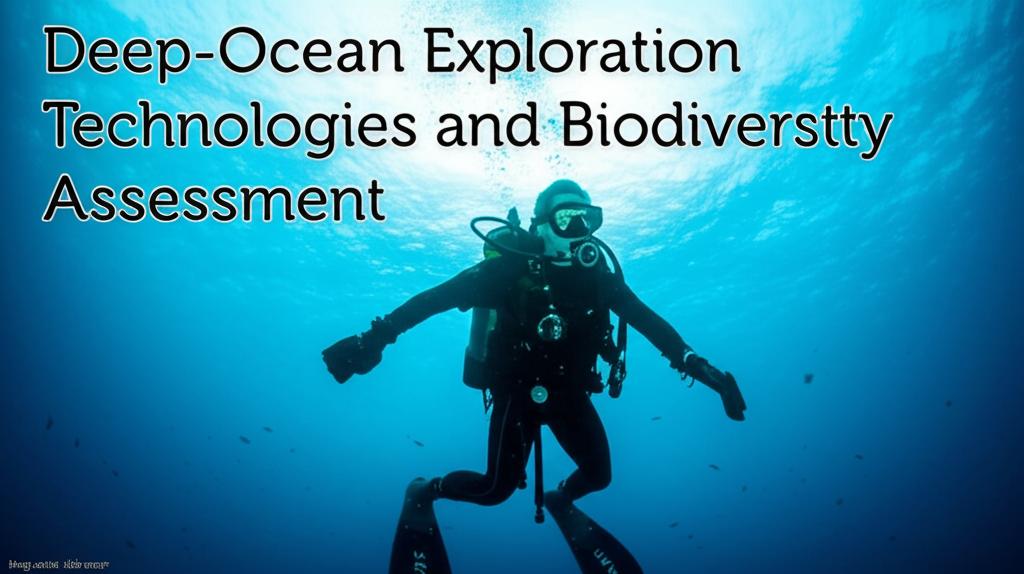The deep sea, covering more than 70% of our planet's surface, remains one of the least explored frontiers. However, a wave of technological advancements is revolutionizing our ability to study this vast and mysterious environment, leading to unprecedented discoveries about its biodiversity. These innovations are critical not only for scientific understanding but also for informed decision-making regarding the conservation and sustainable use of deep-ocean resources, especially in the face of increasing human activities like deep-sea mining and climate change.
Key Technological Advancements:Recent years have witnessed a surge in technologies that are transforming deep-ocean exploration and biodiversity assessment:
- Autonomous and Remotely Operated Vehicles (AUVs & ROVs): These unmanned submersibles are at the forefront of deep-sea exploration. Equipped with high-definition cameras, advanced sensors, and sophisticated sampling tools, AUVs and ROVs can operate at extreme depths (exceeding 6,000 meters) for extended periods. They allow scientists to survey vast areas, capture high-resolution images and videos of deep-sea ecosystems like coral reefs and hydrothermal vents, and collect biological and geological samples with increasing precision. Next-generation ROVs and AUVs feature enhanced manipulator arms and diverse sampling instruments. Some advanced AUVs can even operate autonomously for long durations, hibernating on the seafloor to conserve energy.
- Advanced Imaging and Acoustic Technologies: High-resolution underwater camera systems, including 4K technology and stereo cameras, provide stunningly detailed images and footage of deep-sea life and habitats. These systems utilize advanced sensors for low-light conditions, specialized housings to withstand immense pressure, and calibrated LED arrays to observe natural behaviors with minimal disturbance. Enhanced image stabilization and real-time streaming capabilities further improve data collection. Acoustic technologies, such as multifrequency multibeam bathymetry and synthetic aperture sonar, are crucial for mapping the seafloor and classifying habitats with increasing resolution and accuracy.
- Environmental DNA (eDNA) Analysis: This revolutionary technique allows scientists to assess biodiversity without directly observing or capturing organisms. By collecting and analyzing genetic material shed by organisms into the water (like scales, waste, or cellular debris), researchers can identify the presence of various species, including those that are rare, elusive, or new to science. Modern eDNA samplers can be deployed on AUVs to automatically filter water at various depths over extended periods, providing unprecedented insights into marine biodiversity patterns and species movements.
- Sensors and Observatories: Smart buoys and underwater sensor networks, including cabled observatories connected to onshore research stations, continuously gather crucial data on physical and chemical ocean parameters such as water quality, temperature, salinity, and ocean acidification. Bio-sensors can detect specific organisms or biological processes, aiding in tracking everything from coral reef health to the movement of invasive species. Bioluminescence detection systems, combining high-sensitivity cameras and specialized light sensors, are also revealing new insights into light-emitting deep-sea creatures.
- Artificial Intelligence (AI) and Machine Learning: AI and machine learning are becoming indispensable tools for analyzing the vast amounts of data generated by deep-sea exploration. Deep-learning models are being trained to automatically identify species from video footage and sensor data, overcoming the limitations of manual analysis and improving accuracy. AI also aids in habitat classification from acoustic data, tracking marine animal movements, and even predicting the impacts of climate change on marine biodiversity.
- Improved Navigation and Positioning: Accurate navigation is fundamental to all deep-sea research. Advances from sextants to GPS and Real-Time Kinematic GPS have drastically improved the accuracy of locating samples, observations, and underwater vehicles, allowing for precise co-registration of multiple datasets and integration with environmental and bathymetric maps.
These technological advancements are significantly enhancing our ability to:
- Discover New Species: The deep sea is a reservoir of largely unexplored biodiversity, with many species still unknown to science. Advanced exploration tools are continually leading to the discovery and description of new life forms.
- Understand Ecosystem Dynamics: By providing detailed information on species distribution, abundance, behavior, and interactions, these technologies help scientists understand the complex functioning of deep-sea ecosystems.
- Monitor Environmental Changes: Continuous data collection allows for the tracking of changes in deep-sea environments and biodiversity over time, providing crucial information on the impacts of climate change, pollution, and other human pressures.
- Inform Conservation and Management: A better understanding of deep-sea biodiversity and ecosystems is essential for developing effective conservation strategies and for managing human activities, such as fishing and potential deep-sea mining, in a sustainable manner. Initiatives like the Nippon Foundation-GEBCO Seabed 2030 Project aim to map the entire ocean floor, providing a crucial baseline for these efforts.
The future of deep-ocean exploration points towards even more integrated and sophisticated approaches. This includes the development of more robust materials for deep-sea equipment, sustainable energy solutions for long-term deployments, and enhanced underwater communication systems. The integration of eDNA analysis with optoacoustic imaging and AI is expected to provide a more comprehensive picture of deep-sea biodiversity. Furthermore, technologies developed for deep-sea exploration may even find applications in exploring extraterrestrial oceans.
International collaborations and data-sharing initiatives, such as the UN Decade of Ocean Science for Sustainable Development (2021-2030) and projects like Ocean Census, are crucial for accelerating the pace of discovery and ensuring that the knowledge gained is used to protect these vital, yet vulnerable, ecosystems for generations to come. As human activities increasingly venture into deeper waters, these technological advancements are more critical than ever for ensuring the health and biodiversity of the deep ocean.

